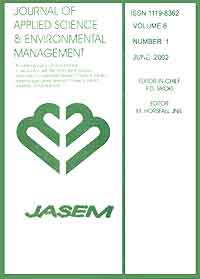
|
Journal of Applied Sciences and Environmental Management
World Bank assisted National Agricultural Research Project (NARP) - University of Port Harcourt
ISSN: 1119-8362
Vol. 11, No. 3, 2007, pp. 35-39
|
 Bioline Code: ja07062
Bioline Code: ja07062
Full paper language: English
Document type: Research Article
Document available free of charge
|
|
|
Journal of Applied Sciences and Environmental Management, Vol. 11, No. 3, 2007, pp. 35-39
| en |
Alternative Economic Technology For Treatment Of Distillery Effluent To Prevent Surface and Ground Water Pollution
Prasad, G.; Rajput, R. & Chopra, A.K.
Abstract
The present study was conducted to find out pollution reduction potential of Sand intermittent filtration
bed in term of physico-chemical and microbiological characteristics of distillery effluent. The distillery effluent was
filtered through Sand intermittent filtration beds of mixture of sand and soil at different ratio i.e. 1:1, 1:3, 3:1 and one set of
100% of each sand and soil were also taken. Results revealed that there was a significant pollution reduction in various
physico-chemical and microbiological parameters of distillery effluent treated with sand and soil filtration. In general
filtration bed containing sand and soil have shown better performance than filtration bed containing only sand or soil for
distillery effluent. Maximum pollution reduction was found in the bed containing sand and soil ratio of 3:1 at 2 ft depth
than all other ratios and depths. However declined trend of pollution did not remain same for several parameters in the
same conditions. Maximum reduced value of pollution load for maximum parameters was recorded at 2 feet dept in sand
soil bed of 3:1 ratio i.e. BOD 82.49%, COD 78.96%. Total alkalinity 75.32%, Turbidity 68.94%, Total solids 94.97%,
Total dissolved solids 95.29%, Total suspended solids 94.16%, MPN 95.14% and SPC 67.21%. Maximum percentage of
reduction in Temperature 59.55% was found at 2 ft depth in soil only. Maximum percentage of reduction in CO2 73.39%
was found at 2 ft depth in sand soil mixed bed of 1:3 ratio. Minimum reduction ability was found in 100% sand bed.
|
| |
© Copyright 2007 - Journal of Applied Sciences & Environmental Management
|
|
